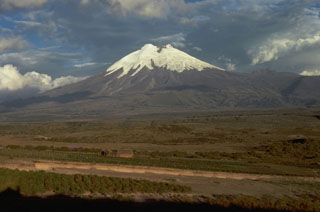Report on Cotopaxi (Ecuador) — 22 February-28 February 2023
Smithsonian Institution / US Geological Survey
Weekly Volcanic Activity Report, 22 February-28 February 2023
Managing Editor: Sally Sennert.
Please cite this report as:
Global Volcanism Program, 2023. Report on Cotopaxi (Ecuador) (Sennert, S, ed.). Weekly Volcanic Activity Report, 22 February-28 February 2023. Smithsonian Institution and US Geological Survey.
Cotopaxi
Ecuador
0.677°S, 78.436°W; summit elev. 5911 m
All times are local (unless otherwise noted)
IG reported that the eruption at Cotopaxi continued during 22-28 February, characterized by almost daily emissions of gas, steam, and ash; inclement weather conditions occasionally prevented views. Gas-and-steam emissions rose 500 m above the crater rim and drifted W during 21-22 February. Weather clouds prevented visual observations of the volcano during most of 23 February, though by the late afternoon and into the next morning steam emissions with low ash content were seen rising 500 m and drifted SW. Gas-and-steam plumes rose 500 m and drifted W on 25 February. Several emissions of gas, steam, and ash rose as high as 2.4 km and drifted SE on 26 February. During periodic breaks in weather clouds, continuous emissions of gas, steam, and ash sere seen rising as high as 1.5 km and drifting E and SE. Minor amounts of ash fell in the province of Pichincha in Rumiñahui (61 km N), Rumipamba Vallecito, Conocoto (41 km N), El Pedregal (60 km N), Guamaní (42 km NNW), Quitumbe (41 km NNW), La Ecuatoriana (44 km NNW), Chillogallo (47 km NNW), Urubamba (Santo Tomas, 40 km NNW), La Magdalena (Barrio Nuevo, Villaflora, 48 km NNW) and San Bartolo. At 1430 on 28 February an ash plume rose 500 m and drifted SW. Servicio Nacional de Gestión de Riesgos y Emergencias (SNGRE) maintained the Alert Level at Yellow (the second lowest level on a four-color scale).
Geological Summary. The symmetrical, glacier-covered, Cotopaxi stratovolcano is Ecuador's most well-known volcano and one of its most active. The steep-sided cone is capped by nested summit craters, the largest of which is about 550 x 800 m in diameter. Deep valleys scoured by lahars radiate from the summit of the andesitic volcano, and large andesitic lava flows extend to its base. The modern edifice has been constructed since a major collapse sometime prior to about 5,000 years ago. Pyroclastic flows (often confused in historical accounts with lava flows) have accompanied many explosive eruptions, and lahars have frequently devastated adjacent valleys. Strong eruptions took place in 1744, 1768, and 1877. Pyroclastic flows descended all sides of the volcano in 1877, and lahars traveled more than 100 km into the Pacific Ocean and western Amazon basin. Smaller eruptions have been frequent since that time.
Sources: Servicio Nacional de Gestión de Riesgos y Emergencias (SNGRE), Instituto Geofísico-Escuela Politécnica Nacional (IG-EPN)

